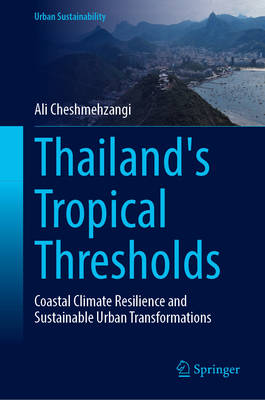
- Afhalen na 1 uur in een winkel met voorraad
- Gratis thuislevering in België vanaf € 30
- Ruim aanbod met 7 miljoen producten
- Afhalen na 1 uur in een winkel met voorraad
- Gratis thuislevering in België vanaf € 30
- Ruim aanbod met 7 miljoen producten
Zoeken
Thailand's Tropical Thresholds
Coastal Climate Resilience and Sustainable Urban Transformations
Ali Cheshmehzangi
€ 213,95
+ 427 punten
Omschrijving
This book dives into in-depth case studies across Thailand's low-lying coastal regions and its rapidly changing urban centers. It focuses on main coastal provinces and regions, where multidisciplinary research shows how hydro-meteorological hazards (such as storm surges, flash floods, erosion) are reshaping both natural environments and human systems. Detailed physico-geomorphological modelling reveals dramatic rates of erosion and accretion, up to -34.5 m/year on mangrove coastlines, versus -4 m/year on sandy beaches, with projections of increased storm severity and flooding because of sea-level rise. The book provides a comprehensive perspective on resilience changes by fusing case-study narratives with institutional analysis, policy evaluation, and UN/Green Climate Fund-backed initiatives. In addition to concrete infrastructure, it highlights nature-based solutions (such as mangrove replanting, sand fences, and crab banks), highlighting the connections between sustainable urban development, multi-scale governance, and local knowledge. In sum, this book offers a detailed yet comprehensive picture of urban and coastal resilience, making it an essential tool for academics, decision-makers, and practitioners involved in climate adaptation in tropical coastal regions.
Specificaties
Betrokkenen
- Auteur(s):
- Uitgeverij:
Inhoud
- Taal:
- Engels
- Reeks:
Eigenschappen
- Productcode (EAN):
- 9789819549740
- Verschijningsdatum:
- 11/01/2026
- Uitvoering:
- Hardcover
- Formaat:
- Genaaid
- Afmetingen:
- 155 mm x 235 mm

Alleen bij Standaard Boekhandel
+ 427 punten op je klantenkaart van Standaard Boekhandel
Beoordelingen
We publiceren alleen reviews die voldoen aan de voorwaarden voor reviews. Bekijk onze voorwaarden voor reviews.








